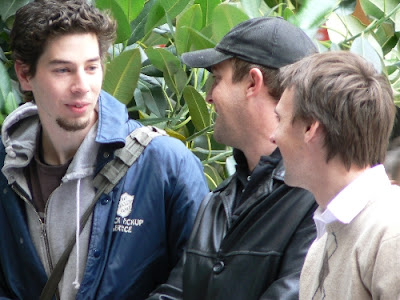 Lorien and Christop take their turn to read the names of those killed in Iraq. It was a deeply moving experience.
Lorien and Christop take their turn to read the names of those killed in Iraq. It was a deeply moving experience. My turn to read the names.
My turn to read the names.We met up around 11 and talked a bit about what we were there for and how we were going to go about reading the names. Then we walked over to Bourke Street and picked a spot right outside the Myer entrance.
Most people walked past us, of course - we reflected later on some ways we could have engaged people better, but for the moment I was content just not to be pushy, and let people come to us if they were interested. And they did - we had quite a few people approach us and ask what it was about. A few people knew about Pine Gap, but not many. The last guy we talked to was actually a doctor from Alice Springs, many of whose patients work at the base. So that made for an interesting discussion.
Mostly though it was useful for us to do this: reading the names out had a particularly significant effect on us all. We read the names, ages, occupations, date they were killed, how they were killed, and where, of both coalition and Iraqi casualties. We wanted to do both to bring a sense of balance and recognise that there are victims on both sides of a war. The emotions it evoked were intense. I went through despair, sadness, frustration, anger, peacefulness. Often it depended on which list I was reading - it was harder to feel sympathy for the coalition casualties, who you knew were there to do a job, and who were there intentionally. Whereas for the Iraqi list, made up mostly of civilians, it was much more poignant; especially when you're acknowledging the deaths of children, unborn babies in their pregnant mothers, farmers, mechanics - not soldiers. Even still, most of the coalition dead were under 24; many as young as 18 and 19. For us it was really as much about repentance as anything - not flagellation, but recognition and genuine regret and solidarity. Realising how complicit we all are in this system of violence and destruction - confessing and repenting of it.
So this turned out to be much more for our good than for anyone else's. And the sense I was left with is that there's such a long way to go. We barely scratched the surface - maybe read 2 or 3 hundred names - of somewhere in the ballpark of 650,000 casualties. The pain of this and the legacy of destruction cannot even begin to be touched. But we've begun.
Some Christop photos here.




No comments:
Post a Comment